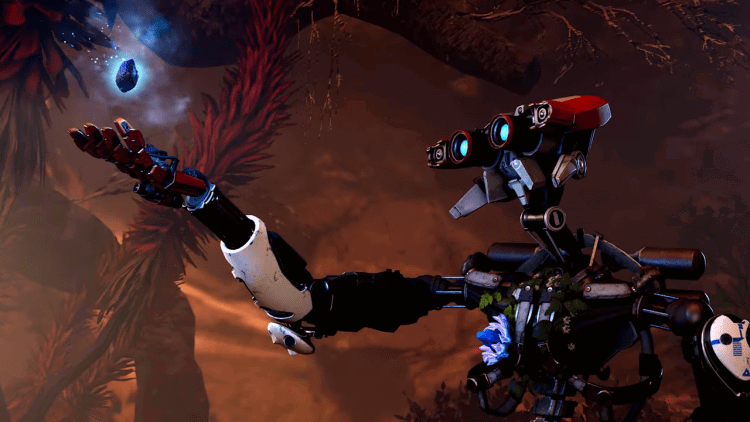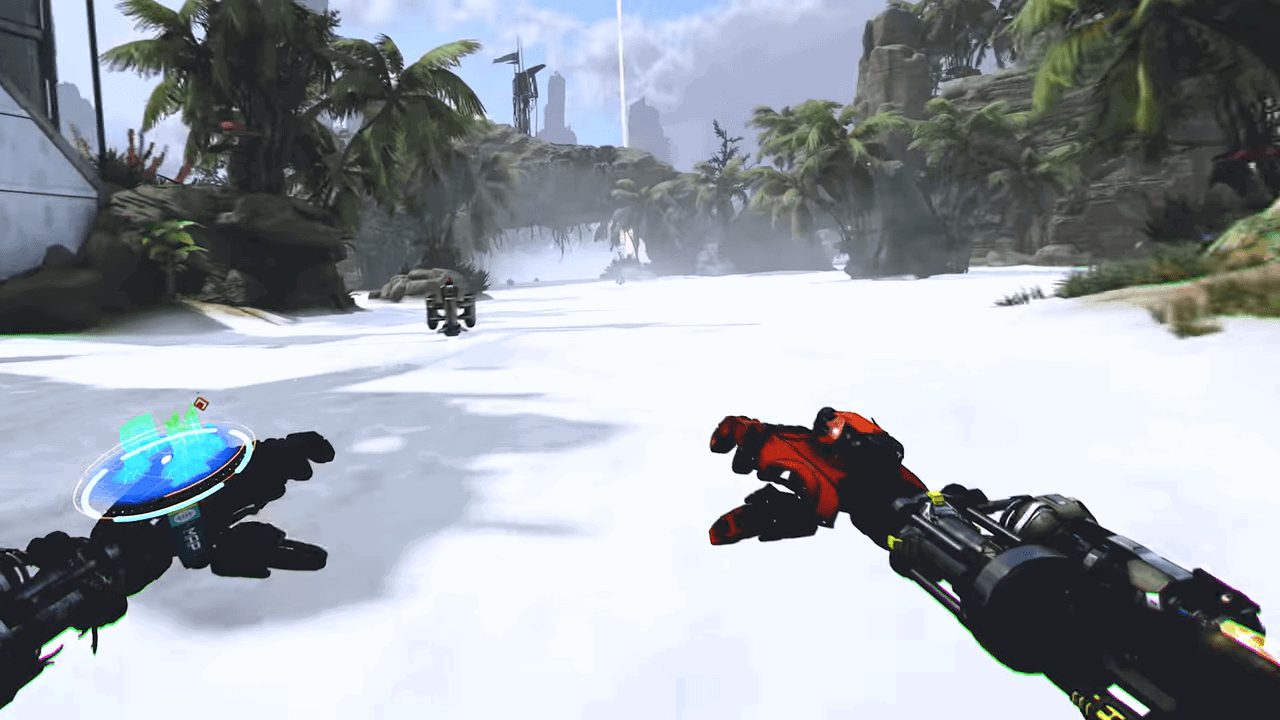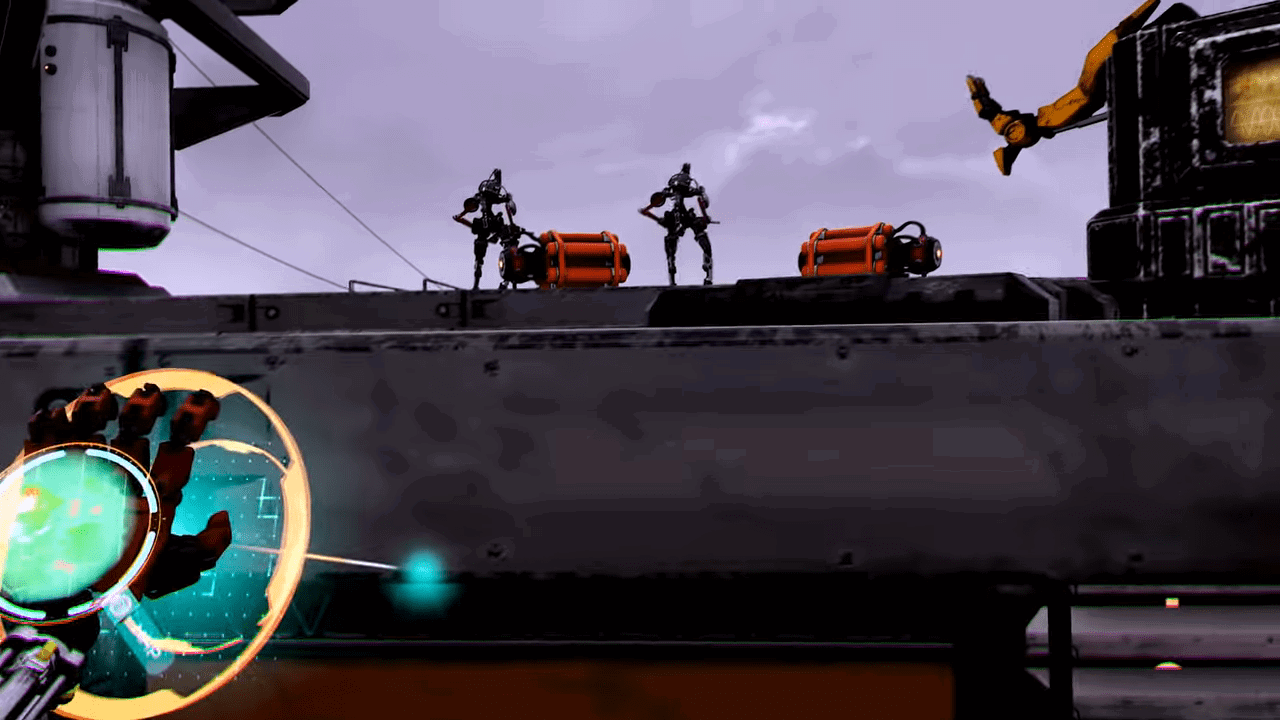The VR scene has evolved significantly over the past year, and we’re finally starting to get our first true AAA VR experiences. Earlier this fall, Asgard’s Wrath floored me with its impressive scope, scale, and quality. Insomniac’s Stormland doesn’t necessarily hit the same highs, but it’s still a solid game that’s worth playing if you have a VR headset.
Game Name: Stormland
Platform(s): Oculus Rift
Publisher(s): Oculus Studios
Developer(s): Insomniac Games
Release Date: November 14, 2019
Price: $39.99
Insomniac has made a few VR titles for Oculus prior to Stormland, but Stormland is the most similar to the games they’ve made for traditional consoles, especially their more recent endeavors. Stormland takes the best parts of Spider-Man and Sunset Overdrive and crams them all into a virtual open-world ripe for exploration, whether you choose to go at it alone or with a friend in online co-op. This is essentially VR Far Cry, but with an awesome movement system that never gets old.

Like Far Cry, Stormland is formulaic and shallow. The story is simple and the mission design is taken from the same blueprint most other modern shooters draw from these days. However, also like Far Cry, you get to shoot lots of cool guns and get involved in bombastic action sequences in single player or co-op, and that tends to make up for the drawbacks. If you’re looking for an engaging story and a long campaign, you’ll want to check out Asgard’s Wrath. The moment to moment gameplay is where Stormland shines.
In Stormland, you play as a robot named Vesper. All of your robotic friends have gone missing, and it’s up to you to regroup with your comrades and take down a menacing mechanical force called the Tempest. There are some interesting story beats once things get going, but for the most part, the narrative is just a reason for you to get out and explore the open world.
The world of Stormland is divided into different regions called “Strata.” These Strata are composed of various islands separated by a sea of clouds that allow you to “Slipstream,” which is a speedy means of traveling between islands. As you Slipstream across the clouds, bumpers will appear in your path, and you’ll get a boost if you dash near them. It sounds easy enough, but steering during a Slipstream is done by using your arms, and the act of simply navigating can become pretty involved.
Of course, Slipstreaming is only the start of Stormland‘s array of movement options. You can climb anything you want ala Breath of the Wild, albeit without any pesky stamina meters. Climbing can be done in the traditional sense of slowly grabbing a bit higher each time, but you can also anchor onto a point and fling yourself upward to get where you need to go faster. Each island is staggeringly vertical, so you’ll be climbing pretty often, whether it be to get the drop on some unaware enemies or just to reach a vantage point to get your bearings.
There’s also a gliding mechanic that pairs wonderfully with climbing. Once you’re airborne, you’re able to glide by pointing your hands in front of you. Aiming downward will propel you forward and give you a boost of speed, and you can repeatedly dive and rise like a Batman Arkham game. All of Stormland‘s movement mechanics work alongside each other to make simply getting from place to place an exciting experience.
When you’re not blazing across the clouds, you’ll be fighting Tempest robots on the various islands. Combat is Stormland is excellent, and it really shines once you start to apply the complex movement to shootouts. Hanging from a ledge and shooting with the other hand is endlessly satisfying, and gliding behind an unaware patrol for easy stealth kills always feels great.
The guns are punchy and have weight to them. Each weapon has both a one-handed and two-handed firing mode, and you can dual wield just about any combination of guns you choose. You’ll have access to other tools in combat as well, like an electrical pulse that does damage at close range or an arm-mounted shield. Shootouts aren’t anything special, but (going back to that Far Cry comparison) it works well enough for what it is.
Unfortunately, Stormland‘s upgrade system falls a bit flat. Each upgrade tier tends to only increase things like damage and ammo count, so upgrades never really feel like a significant improvement. Upgrades to Vesper’s body and movement capabilities are a bit more rewarding, but not by much. In Stormland, trips to a workbench are typically only done out of necessity, not excitement.
However, Stormland‘s incredible UI more than makes up for that. Seeing a hologram of Vesper and physically reaching out and touching the body part you want to upgrade is such a neat novelty. Also, the map and menu are both on your left hand, and the ability to glance at your wrist to check the minimap is a godsend when navigating the samey islands. There’s even a scanner that’s activated by putting a controller to your temple. Every aspect of Stormland‘s UI is intuitively placed on the body, and it’s honestly the greatest VR UI I’ve ever seen. Menus and the like are almost always a pain in VR, but Stormland makes it enjoyable.
Once the relatively short main story wraps up, Stormland enters its pseudo live service phase. Each week, the world resets with a different layout and small modifications, and you’ll be given a new set of missions and objectives as you work your way to the Terminus, the game’s toughest challenge. This is the real meat of Stormland, and the campaign is essentially a drawn-out tutorial.
Unfortunately, things start to fall apart at this stage. The changes made to the world aren’t drastic enough to keep things fresh, and the combat starts to get a bit repetitive. Yes, there’s theoretically a lot of content in Stormland, but it’s recycled and it all kind of blends together. The weekly cycles will keep dedicated players coming back, but there isn’t much in it for the rest of us. It’s like a really toned-down version of a Zelda Master Quest.
Still, Stormland offers a fantastic, if a bit repetitive, open-world VR shooter that’s well worth the price tag for its campaign. The movement is incredibly entertaining, the gunplay is tight, and playing in co-op is one of the best experiences VR has to offer. Sadly, the game loses most of its luster once you hit the endgame, but for $40, there’s more than enough leading up to that to justify the purchase. The story and mission design may be lacking, but the game is fun either way.
Review Disclosure Statement: Stormland was provided to us by Oculus Studios for review purposes. For more information on how we review video games and other media/technology, please go review our Review Guideline/Scoring Policy for more info.
Summary
Stormland‘s idea of an ever-changing world doesn’t provide many reasons to stick around, but the main campaign offers more than enough enjoyable content thanks to punchy shooting and an incredible movement system.
Pros
- Awesome movement system
- Great gunplay
- Fully playable in co-op
- Incredible UI
Cons
- Endgame falls flat
- Weak story
- Combat can get repetitive
- Bland mission design





